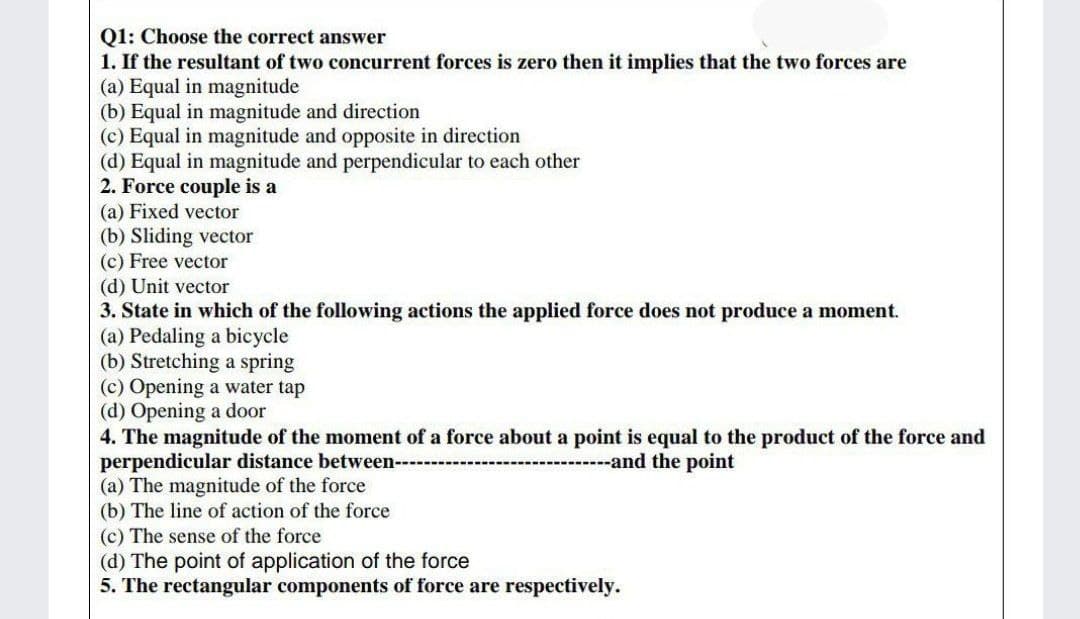1. If the resultant of two concurrent forces is zero then it implies that the two forces are (a) Equal in magnitude (b) Equal in magnitude and direction (c) Equal in magnitude and opposite in direction (d) Equal in magnitude and perpendicular to each other 2. Force couple is a (a) Fixed vector (b) Sliding vector (c) Free vector (d) Unit vector 3. State in which of the following actions the applied force does not produce a moment. (a) Pedaling a bicycle (b) Stretching a spring (c) Opening a water tap (d) Opening a door
1. If the resultant of two concurrent forces is zero then it implies that the two forces are (a) Equal in magnitude (b) Equal in magnitude and direction (c) Equal in magnitude and opposite in direction (d) Equal in magnitude and perpendicular to each other 2. Force couple is a (a) Fixed vector (b) Sliding vector (c) Free vector (d) Unit vector 3. State in which of the following actions the applied force does not produce a moment. (a) Pedaling a bicycle (b) Stretching a spring (c) Opening a water tap (d) Opening a door
University Physics Volume 1
18th Edition
ISBN:9781938168277
Author:William Moebs, Samuel J. Ling, Jeff Sanny
Publisher:William Moebs, Samuel J. Ling, Jeff Sanny
Chapter2: Vectors
Section: Chapter Questions
Problem 60P: A barge is pulled by the two tugboats shown in the following figure. One tugboat pulls on the barge...
Related questions
Question
None

Transcribed Image Text:Q1: Choose the correct answer
1. If the resultant of two concurrent forces is zero then it implies that the two forces are
(a) Equal in magnitude
(b) Equal in magnitude and direction
(c) Equal in magnitude and opposite in direction
(d) Equal in magnitude and perpendicular to each other
2. Force couple is a
(a) Fixed vector
(b) Sliding vector
(c) Free vector
(d) Unit vector
3. State in which of the following actions the applied force does not produce a moment.
(a) Pedaling a bicycle
(b) Stretching a spring
(c) Opening a water tap
(d) Opening a door
4. The magnitude of the moment of a force about a point is equal to the product of the force and
perper
icular distance between---
------and the point
(a) The magnitude of the force
(b) The line of action of the force
(c) The sense of the force
(d) The point of application of the force
5. The rectangular components of force are respectively.
Expert Solution
This question has been solved!
Explore an expertly crafted, step-by-step solution for a thorough understanding of key concepts.
This is a popular solution!
Trending now
This is a popular solution!
Step by step
Solved in 3 steps

Knowledge Booster
Learn more about
Need a deep-dive on the concept behind this application? Look no further. Learn more about this topic, physics and related others by exploring similar questions and additional content below.Recommended textbooks for you

University Physics Volume 1
Physics
ISBN:
9781938168277
Author:
William Moebs, Samuel J. Ling, Jeff Sanny
Publisher:
OpenStax - Rice University

College Physics
Physics
ISBN:
9781938168000
Author:
Paul Peter Urone, Roger Hinrichs
Publisher:
OpenStax College

Physics for Scientists and Engineers: Foundations…
Physics
ISBN:
9781133939146
Author:
Katz, Debora M.
Publisher:
Cengage Learning

University Physics Volume 1
Physics
ISBN:
9781938168277
Author:
William Moebs, Samuel J. Ling, Jeff Sanny
Publisher:
OpenStax - Rice University

College Physics
Physics
ISBN:
9781938168000
Author:
Paul Peter Urone, Roger Hinrichs
Publisher:
OpenStax College

Physics for Scientists and Engineers: Foundations…
Physics
ISBN:
9781133939146
Author:
Katz, Debora M.
Publisher:
Cengage Learning

College Physics
Physics
ISBN:
9781305952300
Author:
Raymond A. Serway, Chris Vuille
Publisher:
Cengage Learning

College Physics
Physics
ISBN:
9781285737027
Author:
Raymond A. Serway, Chris Vuille
Publisher:
Cengage Learning

Principles of Physics: A Calculus-Based Text
Physics
ISBN:
9781133104261
Author:
Raymond A. Serway, John W. Jewett
Publisher:
Cengage Learning